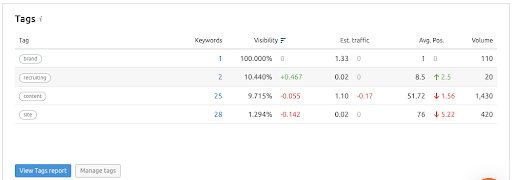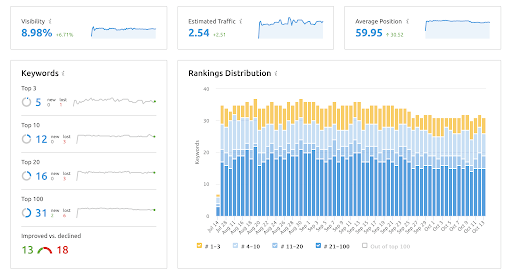How & Why to Monitor Keyword Rankings for Content Marketing Insights
Written by
As Google and other search engines continuously adjust ranking signals to align search results with searcher intent, it’s only natural to expect your keyword positions to be in constant flux.
And it’s not just the search engines that change. If you’re following the inbound methodology or using any form of content marketing, that means your online presence is also dynamic.
Every time you publish new content, you change the landscape.
Plus, market shifts, trends, technology advances, and millions of other variables add up to spur changes in user intent and search behavior.
For all these reasons, your keyword rankings can fluctuate dramatically from one day to the next.
But if your position is constantly changing, what’s the point of monitoring your keyword rankings? And is there a best approach to take, to get actionable insights from the data?
In this article, we’ll cover a few important reasons not to ignore your rankings, as well as how and what to track in terms of your website’s keyword positions.
Why Keyword Position is Still A Key Concern
Keyword position monitoring does much more than show you where you rank on SERPs. As a practice, it can be a source of several important insights, helping you:
- Increase your website’s visibility
- Discover traffic drops due to algorithm updates, so you can address them before they become a major issue
- Identify which pages of your website rank for your most important keywords, so you can even more effectively optimize those pages for conversion
- Improve your insights into target personas’ user intent, which can inform new content needs, identify gaps and strengthen strategy roadmaps
- Keep an eye on competitors and learn from their successes and failures
- Demonstrate and report on results of your content strategy and tactical decisions, like the effects of campaigns, newly added landing pages, and content refreshes
- Uncover quick-win opportunities for piece-of-cake keywords your competitors are missing out on
How to Get Started Monitoring Keyword Rankings
As with most SEO-related tasks, you have several options for tracking your keywords’ rankings on different search engines’ results, identifying related keywords and long-tail keyword phrases, and learning more about your top competitors. Databox does a great job reviewing the top 24 SEO-expert recommended keyword tracking tools. Among their most recommended, you’ll find:
We’ll use SEMRush as the SEO tool in our example. Its Position Tracking feature allows you to track your website’s daily rankings for your selected keywords. It can show you how your content and SEO efforts result in keyword ranking changes, and which of your website pages bring in the most traffic from your target keywords.
The insights you glean from your position tracking data can help you identify pages that need improvements, and you can also use it to keep an eye on your competitors’ rankings.
To create a new project in SEMRush, click the “Add new project” button.
![]()
It’s recommended to enter the root domain rather than the www-version of your site (e.g., weidert.com instead of www.weidert.com), so your whole site can be crawled, and not just a www subdomain.
Once inside your project, on the Position Tracking tile, click “Set up” and select “as Root domain,” “Google,” and “Desktop” or “Mobile,” based on your target audience’s preference. To filter results geographically, set a location. (Don’t worry; you can add more device types and locations after completing the initial setup.)
Next, Google your business and copy-and-paste the name into “Business name for local map pack,” exactly as it’s displayed in Google’s local map pack or knowledge graph.

How to Choose Which Keywords to Track
Track keywords that are important to your business. For example:
- Your topic clusters’ head keywords
- Top keywords by traffic
- Top keywords by conversion
- Primary (especially purchase-intent) keywords for your most important non-blog pages
- Core branded keywords
- Topic cluster long-tail keywords
- Topic keywords of main competitors
If you run out of space, remember, you can always swap keywords in and out as you need to.
RELATED: Keyword Research: Building a Better Blog Calendar
Tagging Keywords & Adding Notes
If the tool you choose allows you to tag keywords, organizing them into groups, you can monitor and track their metrics as a working unit.
You might tag keywords by topic cluster, by age (last year’s versus this year’s), by intent, by volume or difficulty, or by location for geographically specific keywords.
Tagging helps build more contextual insights into the data on share of voice, visibility percentage, estimated traffic, and average position, to give you a more complete understanding of keyword performance. Segmenting keywords in this way is especially helpful to reveal performance insights of campaigns and other specific initiatives.

Adding notes about dates and details of campaigns, site maintenance, or newly added pages or content can help you correlate spikes or drops with your activities.
Tracking & Reporting Keyword Ranking Changes
For more efficient use of ranking and monitoring tools, it’s important to set up alerts and reports so that you stay focused on the most meaningful information about changes in keyword rankings, and don’t get stuck in the weeds, stalking the movement of every individual keyword. You don’t have time for that, and a big volume of granular information is hard to act on.

At the same time, tracking the movement of specific, significant keywords on your domain is essential to your ability to diagnose contributing factors to declines in your site’s organic traffic.
Set up notifications alerting you to notable changes in organic positions (not paid). These are triggered by the selected movement of any tracked keyword. You can set up alerts for competitor rank changes, too. You can, for example, set up alerts if a keyword:
- Enters the top 10
- Leaves the top 10
- Changes rank by more than 10
When it comes to setting up alerts, consider what kind of information you would want to know, and potentially act on, in between regular monthly metrics reporting.
Use Keyword Data to Make Strategic Improvements
Remember, newly published and refreshed content don’t guarantee positive results in terms of your keyword ranking. The landscape is in constant flux, and the variables are too many to count. You and your competitors are continuously updating and changing content. Search terms and behaviors evolve, too.
But positive impact on your keyword rankings, among other SEO metrics, should be a goal, and a key performance indicator, for any initiatives that involve creating, refreshing, or improving on your website content. Learn more about tools, methods, and the many factors that contribute to your website’s traffic — and the conversion of those visitors into leads — with our SEO Survival Guide. Click the link below to dig right in, and download a copy to take along or share.
Subscribe To Our Blog
Information. Insights. Ideas. Get notified every time a new Weidert Group blog article is published – subscribe now!
You May Also Like...

Artificial Intelligence
Revenue-Driving B2B Content Marketing Strategy with Andy Crestodina

Artificial Intelligence
AI Agents Are Here—How Smart Businesses Are Using Them Now

Inbound Marketing
Podcasting Playbook: What We Learned After 100 Days of Running a B2B Podcast
Accelerate Your Growth with
Weidert Group
If you’re ready to explore a partnership, request a personalized consultation with our team.

